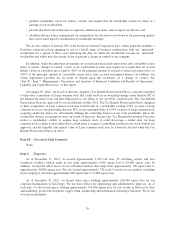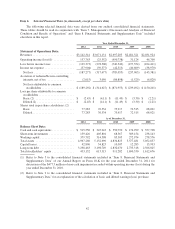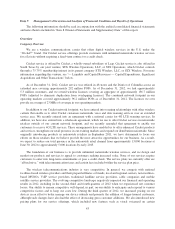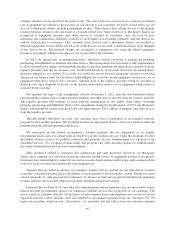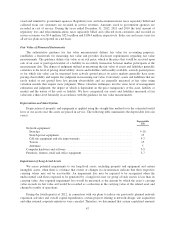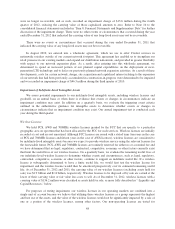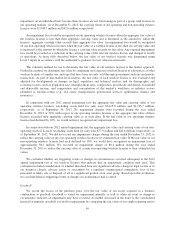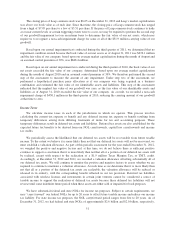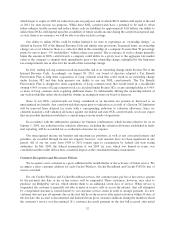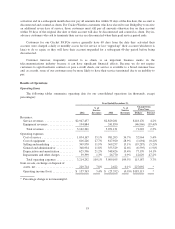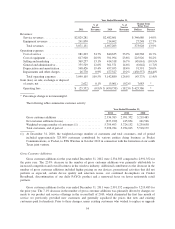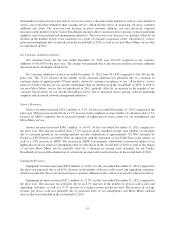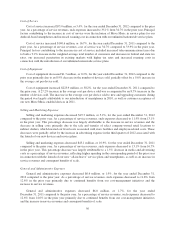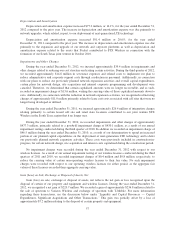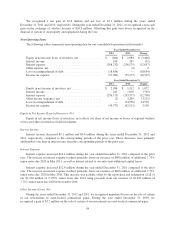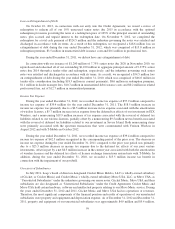Cricket Wireless 2012 Annual Report Download - page 63
Download and view the complete annual report
Please find page 63 of the 2012 Cricket Wireless annual report below. You can navigate through the pages in the report by either clicking on the pages listed below, or by using the keyword search tool below to find specific information within the annual report.impairment on an individual basis because these licenses are not functioning as part of a group with licenses in
our operating markets. As of December 31, 2012, the carrying values of our operating and non-operating wireless
licenses were $1,904.7 million and $42.6 million, respectively.
An impairment loss would be recognized on our operating wireless licenses when the aggregate fair value of
the wireless licenses is less than their aggregate carrying value and is measured as the amount by which the
licenses’ aggregate carrying value exceeds their aggregate fair value. An impairment loss would be recognized
on our non-operating wireless licenses when the fair value of a wireless license is less than its carrying value and
is measured as the amount by which the license’s carrying value exceeds its fair value. Any required impairment
loss would be recorded as a reduction in the carrying value of the relevant wireless license and charged to results
of operations. As more fully described below, the fair value of our wireless licenses was determined using
Level 3 inputs in accordance with the authoritative guidance for fair value measurements.
The valuation method we use to determine the fair value of our wireless licenses is the market approach.
Under this method, we determine fair value by comparing our respective wireless licenses to sales prices of other
wireless licenses of similar size and type that have been recently sold through government auctions and private
transactions. As part of this market-level analysis, the fair value of each wireless license is also evaluated and
adjusted for developments or changes in legal, regulatory and technical matters, and for demographic and
economic factors, such as population size, unemployment rates, composition, growth rate and density, household
and disposable income, and composition and concentration of the market’s workforce in industry sectors
identified as wireless-centric (e.g., real estate, transportation, professional services, agribusiness, finance and
insurance).
In connection with our 2012 annual impairment test, the aggregate fair value and carrying value of our
operating wireless licenses (excluding assets held for sale) were $2,415.0 million and $1,745.7 million,
respectively, as of September 30, 2012. No impairment charges were recorded during the year ended
December 31, 2012 or 2011 with respect to our operating wireless licenses as the aggregate fair value of these
licenses exceeded their aggregate carrying value as of such dates. If the fair value of our operating wireless
licenses had declined by 10%, we would not have recognized any impairment loss.
In connection with our 2012 annual impairment test, the aggregate fair value and carrying value of our non-
operating wireless licenses (excluding assets held for sale) were $77.9 million and $42.6 million, respectively, as
of September 30, 2012. We did not record any impairment charges during the year ended December 31, 2012 to
reduce the carrying value of any non-operating wireless license to its estimated fair value. If the fair value of our
non-operating wireless licenses had each declined by 10%, we would have recognized an impairment loss of
approximately $0.1 million. We recorded an impairment charge of $0.4 million during the year ended
December 31, 2011 to reduce the carrying value of certain non-operating wireless licenses to their estimated fair
values.
We evaluated whether any triggering events or changes in circumstances occurred subsequent to the 2012
annual impairment test of our wireless licenses that indicate that an impairment condition may exist. This
evaluation included consideration of whether there had been any significant adverse change in legal factors or in
our business climate, adverse action or assessment by a regulator, unanticipated competition, loss of key
personnel or likely sale or disposal of all or a significant portion of an asset group. Based upon this evaluation,
we concluded that no triggering events or changes in circumstances had occurred.
Goodwill
We record the excess of the purchase price over the fair value of net assets acquired in a business
combination as goodwill. Goodwill is tested for impairment annually as well as when an event or change in
circumstance indicates an impairment may have occurred. As further discussed in the notes to the consolidated
financial statements, goodwill is tested for impairment by comparing the fair value of our single reporting unit to
49


